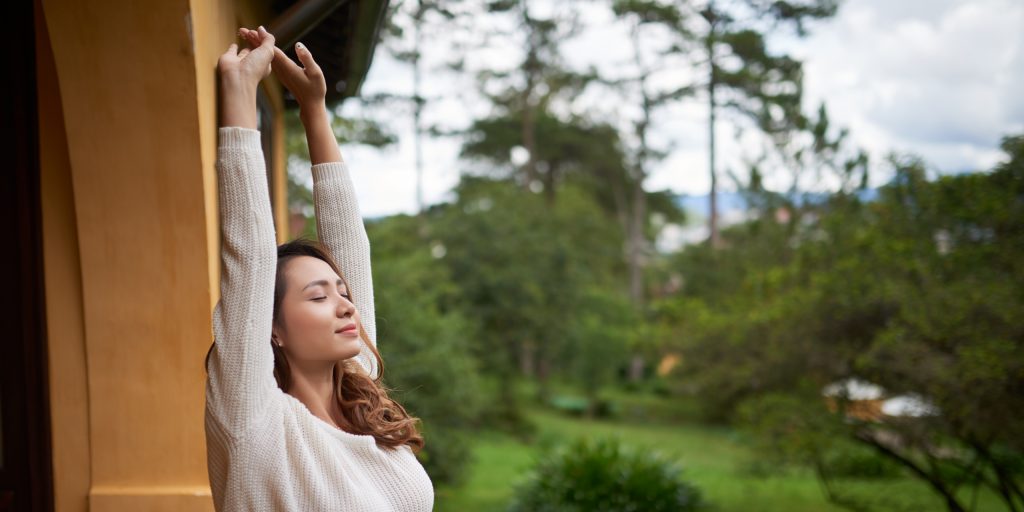
Articles
SleepScore at the ATN Innovation Summit 2025: Why Sleep Drives Everything
Reimagining The World of Sleep SleepScore Labs was proud to take part in the ATN Innovation Summit 2025, an elite gathering…
Introducing SleepScore
We deliver accurate data, actionable insights, personalized coaching and proven outcomes your customers need.
Sleep Insights
Last Published on 29th May 2018 by SleepScore Labs

While we all breathe thousands of times per day without a second thought, the positive impact that comes with taking deep, conscious breaths is stronger than you think. The beneficial health effects of deliberate deep breathing are well known in medicine, psychology, and sleep science.
You may be experiencing sleep problems due to a variety of factors. Anything from medical conditions to simply not practicing healthy sleep hygiene habits could be to blame. Let’s not forget that as we go through life we age, we feel stress, we change living environments, and we pick up new habits; all of which can contribute to sleep problems in the long term.
Breathing techniques can be a simple yet powerful tool to help you relax, find your center, regain balance, and ultimately improve your life and your sleep.
Dr. Sharon Danoff-Burg, a clinical psychologist and Senior Research Scientist at SleepScore Labs, explains, “When we feel stressed or anxious, we tend to take shallow breaths in the upper chest instead of breathing deeply using the full capacity of our lungs. We might tighten up our muscles, start breathing in irregular patterns, take rapid breaths, or even hold our breath without realizing it. The good news is this can be changed with practice, so we feel better and sleep better.”
Breathing exercises are a type of relaxation technique that help promote relaxation, improve mood, support mindfulness, and reduce stress levels. Additionally, breathing exercises may help reduce the tension that can interfere with sleep, including trouble falling asleep and staying asleep.
Do you find it hard to fall asleep after a hectic day? Even when loosened up and ready to sleep, do you struggle with getting your eyes shut? If this is you, breathing exercises may help you relax and fall asleep more quickly. This practice can be as simple as taking slow, deep breaths, making sure to spend plenty of time on the exhalation. However, many people find it easiest to follow a structured breathing exercise that includes counting or other guidance.
Here are 7 breathing techniques that may support healthy sleep. Give them a try to discover which feels best for you. If at any point you start to feel lightheaded or uncomfortable, return your breathing back to what feels normal and restful.
Counting breaths is a very simple breathing exercise in which you count your breaths as you gently inhale through your nose and slowly exhale through your mouth. You can repeat this until you fall asleep.
Studies suggest that this breathing exercise may improve mood, help you feel grounded, and keep your mind focused and at rest.
Here are the steps:
Diaphragmatic breathing has been shown in numerous studies to promote relaxation, decrease stress, and provide overall benefit to physical, mental, and emotional health.
The diaphragmatic breathing technique is also called belly breathing or deep breathing. The name refers to engaging the diaphragm, which is the central respiratory muscle that sits below the lungs between the chest and abdomen.
In this breathing exercise, you practice breathing deeply by paying attention to breathing in and out without your upper chest moving much. Some people even place a book on their chest while practicing. It might sound hard, but this is the way babies breathe naturally, so your body already knows how to do it.
Here are the steps:
Box breathing, also called four-square or square breathing, is an equal-ratio yogic breathing exercise that can help you feel grounded, release stress from your body, and help you feel calm. A study in India found that this breathing technique helped new mothers feel relief from physical pain.
Here are the steps:
These techniques refer to how long to inhale, hold, and exhale each breath. Done lying down, sitting, or standing, the 4-4-8 technique or the 4-7-8 technique can help you relax. The authors of a study on 4-7-8 breathing noted that it activates the parasympathetic nervous system (the rest, digest, and recovery part of the nervous system), slowing down the heart rate, breathing rate, and promoting relaxation. These mechanisms can support a refreshing night’s rest.
Here are the steps:
Roll breathing is a variation on diaphragmatic breathing, discussed earlier. The aim is to become familiar with the rhythm of your breathing and use your total lung capacity as you inhale and exhale. It’s recommended to practice this first, lying on your back with your knees bent until you get the knack. From there, it’s doable in other positions, anytime you need to relax.
Here are the steps:
Bhramari pranayama is another breathing exercise that may help you relax and fall asleep. There are different variations of this ancient practice. One study by researchers in Nepal found that just 5 minutes of this practice lowered blood pressure and heart rate.
Here are the steps:
After a lovely night of sleep, kick-start your body with a boost of oxygen and a mindful breathing exercise to open air passages and clear the morning fog. Researchers in China have used morning breathing exercises to help people with lung cancer. As with most relaxation techniques, there are different variations on how to do it. Over time, you will figure out what works best for you.
Here are the steps:
Carving out a few minutes each day to practice any one of these breathing techniques can help restore your energy, relax the body and mind, and provide a peace-inducing return to a centered and wholesome state.
These techniques may help you get consistent recovery sleep and support your sleep health. Give them a try and see how they help you, day or night!